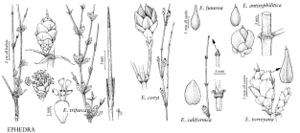Difference between revisions of "Ephedra funerea"
J. Wash. Acad. Sci. 25: 307. 1935.
FNA>Volume Importer |
imported>Volume Importer |
||
| (3 intermediate revisions by 2 users not shown) | |||
| Line 8: | Line 8: | ||
}} | }} | ||
|common_names=Death Valley ephedra | |common_names=Death Valley ephedra | ||
| + | |special_status={{Treatment/ID/Special_status | ||
| + | |code=E | ||
| + | |label=Endemic | ||
| + | }}{{Treatment/ID/Special_status | ||
| + | |code=C | ||
| + | |label=Conservation concern | ||
| + | }} | ||
|basionyms= | |basionyms= | ||
|synonyms={{Treatment/ID/Synonym | |synonyms={{Treatment/ID/Synonym | ||
|name=Ephedra californica var. funerea | |name=Ephedra californica var. funerea | ||
|authority=(Coville & C. V. Morton) L. D. Benson | |authority=(Coville & C. V. Morton) L. D. Benson | ||
| + | |rank=variety | ||
}} | }} | ||
|hierarchy=Ephedraceae;Ephedra;Ephedra funerea | |hierarchy=Ephedraceae;Ephedra;Ephedra funerea | ||
| Line 36: | Line 44: | ||
-->{{#Taxon: | -->{{#Taxon: | ||
name=Ephedra funerea | name=Ephedra funerea | ||
| − | |||
|authority=Coville & C. V. Morton | |authority=Coville & C. V. Morton | ||
|rank=species | |rank=species | ||
| Line 50: | Line 57: | ||
|publication title=J. Wash. Acad. Sci. | |publication title=J. Wash. Acad. Sci. | ||
|publication year=1935 | |publication year=1935 | ||
| − | |special status= | + | |special status=Endemic;Conservation concern |
| − | |source xml=https:// | + | |source xml=https://bitbucket.org/aafc-mbb/fna-data-curation/src/2e0870ddd59836b60bcf96646a41e87ea5a5943a/coarse_grained_fna_xml/V2/V2_528.xml |
|genus=Ephedra | |genus=Ephedra | ||
|species=Ephedra funerea | |species=Ephedra funerea | ||
Latest revision as of 21:24, 5 November 2020
Shrubs erect, 0.25–1.5 m. Bark gray, slightly cracked and irregularly fissured. Branches alternate or whorled, rigid, angle of divergence about 60°. Twigs gray-green, becoming gray with age, glaucous, slightly scabrous, with numerous very fine longitudinal grooves; internodes 2–6 cm. Terminal buds conic, 1–4 mm, apex acute. Leaves in whorls of 3, 2–6 mm, connate to 2/3–3/4 their length; bases splitting at margins, persistent, forming black, thickened collar; apex acute. Pollen cones 1–3 at node, narrowly ellipsoid, 5–8 mm, on very short, scaly peduncles (rarely sessile); bracts in 6–9 whorls of 3, light yellow, ovate, 3–4 × 2–3 mm, membranous, base short-clawed; bracteoles equaling bracts; sporangiophores 3–5 mm, exserted to 1/3 their length, with 3–7 sessile to short-stalked microsporangia. Seed cones 1–3 at node, lance-obovoid, 8–15 mm, on short, scaly peduncles (rarely sessile); bracts in 6–9 whorls of 3, obovate, 4–8 × 3–5 mm, papery, yellow-translucent with green-yellow center and base, base broadly clawed, margins slightly dentate. Seeds 1(–3), ellipsoid, 6–10 × 2–4 mm, pale green to light brown, smooth to scabrous.
Phenology: Coning March–April.
Habitat: Sandy, dry soil and rocky scrub areas
Elevation: 500–1500 m
Discussion
Of conservation concern.
Selected References
None.

